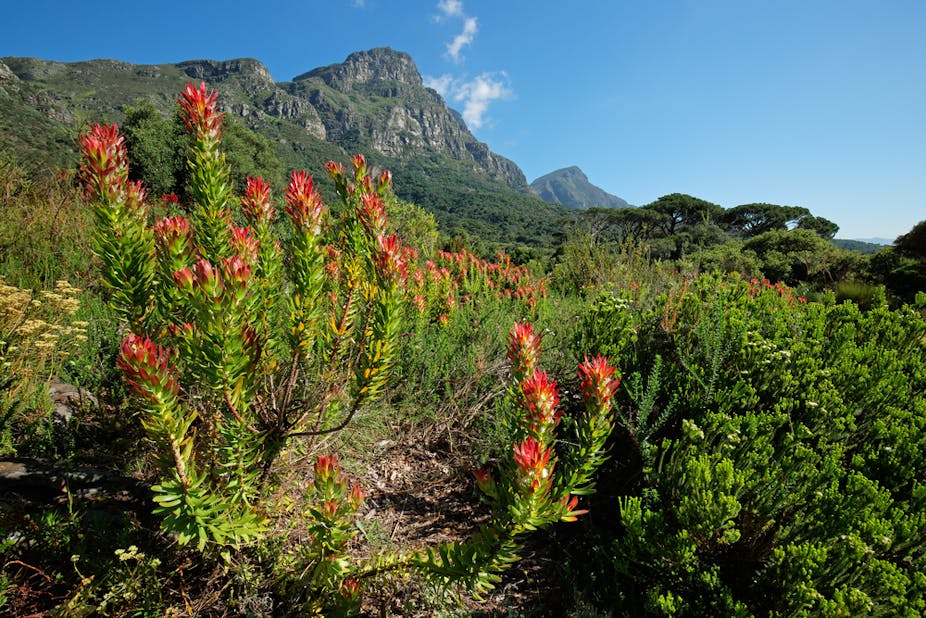Biodiversity, the variety of life on earth (plants, animals and the ecosystems in which they live), underpins the planet’s life support systems and consequently human well-being. Unprecedented, large-scale biodiversity loss currently threatens the sustainability of these systems, such as the sustained supply of clean water.
As part of a global response numerous international agreements provide road maps for effective and urgent action. For example 196 countries, as signatories to the Convention on Biological Diversity, have agreed to a set of targets that would contribute to slowing the loss of biodiversity globally. But conserving biodiversity is not enough. Focus is also needed on restoring damaged and degraded habitats.
South Africa has committed to restore at least 15% of degraded ecosystems by 2020. The complex task of getting the job done has begun. But as with most things, the devil is in the detail.
Conservation success has a great deal to do with understanding the biology of habitats and species. But it is also about understanding the role that people play in the landscape, and the values they hold.
These issues tend to erupt where urban areas interface with nature, because the boundaries are unpredictable and risky and involve many competing views and values.
The polarised battle playing out in Tokai Park in the Western Cape is a microcosm of the world of potential conflict where natural environment interfaces with multiple social values. Here the tension is between those who want to remove pine trees to create space to restore a threatened indigenous plant community, and those who want the pine tree plantation to remain.
The Tokai Park debate, now in the realm of the courts, is a minor social issue in the context of the city. But it provides a window into the complex world of conservation where social issues intersect with ecology. So far efforts to find common ground have failed, highlighting how important it is to create conditions where opposing views can be debated, and common cause found in the fight to protect biodiversity.
Two worlds collide
Tokai Park is situated at the interface between urban development and one of the world’s most globally iconic habitats, fynbos - a floral region with plants unique to South Africa. Tokai Park forms part of Cape Town’s Table Mountain National Park and is managed by SANPARKS, a national conservation agency.
The region is home to unparalleled fynbos plant diversity and has been identified as a global biodiversity hot-spot. It is also haven for a dwindling specialised habitat with nowhere else to go, Cape Flats Sand Fynbos.
Urbanization has nearly wiped out Cape Town’s Cape Flats Sand Fynbos. The last critically endangered habitat is uniquely confined to the city of Cape Town.
South Africa has committed, through global targets and international agreements such as the Convention on Biological Diversity, to protect and restore remaining natural habitats. And the remnants of this, and other threatened habitats, have been a focus of conservation attention for the local conservation agencies.
Parkscape, a Cape Town community group, recently mobilised enough support to temporarily prevent conservation authorities from maintaining a pine plantation in the specialised habitat.
Pines have been planted in the Cape over centuries. But their competitive dominance over fynbos and their water-guzzling ways have made them uncomfortable conservation companions.

So the chance to return a pine stand at the end of its commercial lifespan to its former fynbos-diverse natural glory seemed like a win-win solution.
But a fierce, largely middle class, lobby has put its weight behind retaining the non-native pines. The two sides have gone to court to try and settle the matter.
The commercial pine plantation is used for riding horses, walking dogs and a picnic spot in the summer. The small, well-resourced group defending it has garnered enough support to stay the fate of the pine trees.
Exchanges on social media provide an insight into the many ethical and moral values tied up in the issue.
There are those who argue that the area will become a magnet for criminals, citing a murder that occurred in nearby fynbos. Others are sentimental about the forest because it’s where they find solace and shade. Both sides point to the fact that pines as well as fynbos are sources of value such as medicines and wood.
But some key questions need to be asked. These include: can shade be provided in alternative ways? The answer is certainly yes. Native trees can provide suitable shade too. How fair is it to associate all future crime with restored fynbos? Crime happens everywhere. Cape Flats Sand Fynbos may well be a victim of crime-by-association.
A way out of the impasse
It is clear that conservation agencies have difficulty doing their work when social conflicts erupt.
The answer lies in concerted action to work with people who hold alternative views. In doing so, and by acknowledging their views, commonality can often be found.
But how can this be achieved?
Conservation agendas will only be advanced if people engaged in conservation can navigate social-ecological spaces and engage with multiple, often conflicting values, to try and find common ground.
Our teaching and research at Stellenbosch University is focused on conservation in used environments. That means we think about applied problems that often require multiple perspectives to resolve. We expose our students to these multiple perspectives, sensitising them to the challenges of working in a social-ecological context.
But understanding how to conduct appropriate public participation requires more.
A blend of skills is needed, including public communication, conflict management and facilitation. But these are difficult to incorporate into science-based degrees. Training opportunities need to be scaled up as well as innovative interdisciplinary collaboration.
Ecological restoration brings with it a message of hope. By repairing habitat suited to other living organisms, the services provided by these habitats are also returned to us. But unless we can convince the people of its value, and mediate surrounding conflicts, we are doomed to fail.

